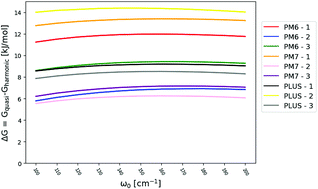Benchmarking sampling methodology for calculations of Rayleigh light scattering properties of atmospheric molecular clusters†
Abstract
We present four different computational methods for benchmarking the sampling and Rayleigh light scattering of atmospheric molecular clusters containing hydrogen bonds. For sampling the cluster configurational space we test both the semi-empirical PM6 and PM7 methods, as well as the density functional ωB97X-D with the 6-31G and 6-31++G(d,p) basis sets. As a model system we study clusters consisting of one hydrogen peroxide molecule (H2O2) and 1–5 water molecules. Hydrogen peroxide is an important constituent in the atmosphere where it acts as an oxidant. We find that all the sampling methods show conformational dissimilarities for the studied (H2O2)(H2O)1–5 clusters. Notably the results for the largest studied (H2O2)(H2O)5 cluster show that the sampling methods perform very differently in finding the same low Gibbs free energy conformers. We consider the magnitude of elastic Rayleigh light scattering of the clusters and how the scattering depends on the number of water molecules in the clusters. We observe that the final Boltzmann averaged Rayleigh scattering is independent of the sampling method and that the inexpensive semi-empirical methods can be applied without loss of accuracy. This implies that Rayleigh scattering is a robust property that does not depend significantly on cluster conformations, but instead mainly on the composition of the cluster.



 Please wait while we load your content...
Please wait while we load your content...